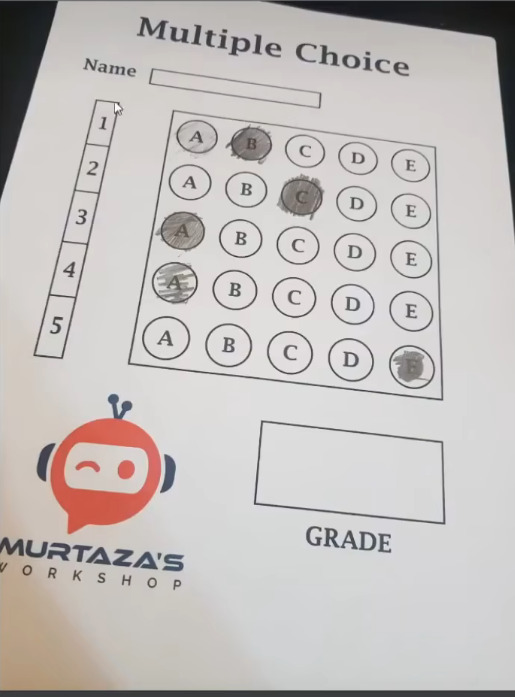对于opencv答题卡识别实战项目的代码问题
出现诸多错误请问怎么解决

import numpy as np
import imutils
import cv2
image_path = r"F:\pythonnotebook\123.jpg"
image = cv2.imread(image_path)
# 正确答案
ANSWER_KEY = {0: 1, 1: 2, 2: 0, 3: 2, 4: 4}
def order_points(pts):
# 一共4个坐标点
rect = np.zeros((4, 2), dtype="float32")
# 按顺序找到对应坐标0123分别是 左上,右上,右下,左下
# 计算左上,右下
s = pts.sum(axis=1)
rect[0] = pts[np.argmin(s)]
rect[2] = pts[np.argmax(s)]
# 计算右上和左下
diff = np.diff(pts, axis=1)
rect[1] = pts[np.argmin(diff)]
rect[3] = pts[np.argmax(diff)]
return rect
def four_point_transform(image, pts):
# 获取输入坐标点
rect = order_points(pts)
(tl, tr, br, bl) = rect
# 计算输入的w和h值
widthA = np.sqrt(((br[0] - bl[0]) ** 2) + ((br[1] - bl[1]) ** 2))
widthB = np.sqrt(((tr[0] - tl[0]) ** 2) + ((tr[1] - tl[1]) ** 2))
maxWidth = max(int(widthA), int(widthB))
heightA = np.sqrt(((tr[0] - br[0]) ** 2) + ((tr[1] - br[1]) ** 2))
heightB = np.sqrt(((tl[0] - bl[0]) ** 2) + ((tl[1] - bl[1]) ** 2))
maxHeight = max(int(heightA), int(heightB))
# 变换后对应坐标位置
dst = np.array([
[0, 0],
[maxWidth - 1, 0],
[maxWidth - 1, maxHeight - 1],
[0, maxHeight - 1]], dtype="float32")
# 计算变换矩阵
M = cv2.getPerspectiveTransform(rect, dst)
warped = cv2.warpPerspective(image, M, (maxWidth, maxHeight))
# 返回变换后结果
return warped
def sort_contours(cnts, method="left-to-right"):
reverse = False
i = 0
if method == "right-to-left" or method == "bottom-to-top":
reverse = True
if method == "top-to-bottom" or method == "bottom-to-top":
i = 1
boundingBoxes = [cv2.boundingRect(c) for c in cnts]
(cnts, boundingBoxes) = zip(*sorted(zip(cnts, boundingBoxes),
key=lambda b: b[1][i], reverse=reverse))
return cnts, boundingBoxes
def cv_show(name, img):
cv2.imshow(name, img)
cv2.waitKey(0)
cv2.destroyAllWindows()
# 读取命令行参数指定的图片
image = cv2.imread(r"F:\pythonnotebook\123.jpg")
contours_img = image.copy()
gray = cv2.cvtColor(image, cv2.COLOR_BGR2GRAY)
blurred = cv2.GaussianBlur(gray, (5, 5), 0)
cv_show('blurred', blurred)
edged = cv2.Canny(blurred, 45, 200)
cv2.imshow('edged', edged)
cv2.waitKey(0)
cv2.destroyAllWindows()
# 锐化处理
kernel = np.array([[-1, -1, -1], [-1, 9, -1], [-1, -1, -1]])
sharpened = cv2.filter2D(gray, -1, kernel)
# 轮廓检测
contours, hierarchy = cv2.findContours(edged.copy(), cv2.RETR_EXTERNAL, cv2.CHAIN_APPROX_SIMPLE)
cnts = contours
# 打印轮廓数据类型和长度
print(type(cnts))
print(len(cnts))
# 根据轮廓大小进行排序
cnts = sorted(cnts, key=cv2.contourArea, reverse=True)
docCnt = None
# 遍历每一个轮廓
for c in cnts:
# 近似
peri = cv2.arcLength(c, closed=True)
approx = cv2.approxPolyDP(c, 0.02 * peri, closed=True)
# 准备做透视变换
if len(approx) == 4:
docCnt = approx
break
# 执行透视变换
if docCnt is not None:
warped = four_point_transform(gray, docCnt.reshape(4, 2))
cv_show('warped', warped)
# Otsu's 阈值处理
thresh = cv2.threshold(warped, 0, 255,
cv2.THRESH_BINARY_INV | cv2.THRESH_OTSU)[1]
cv_show('thresh', thresh)
thresh_contours = thresh.copy()
# 找到每一个圆圈轮廓
cnts = cv2.findContours(thresh.copy(), cv2.RETR_EXTERNAL,
cv2.CHAIN_APPROX_SIMPLE)[1]
if len(cnts) == 0:
print("未检测到圆圈轮廓,请检查图片或调整阈值处理参数!")
import sys
sys.exit(1)
cv2.drawContours(contours_img, contours, -1, (0, 255, 0), 2)
cv_show('thresh_contours', thresh_contours)
questionCnts = []
for c in cnts:
try:
# 强制类型转换 + 维度检查
c = np.array(c, dtype=np.int32).reshape(-1, 1, 2)
if len(c) < 1: # 完全空的情况
continue
(x, y, w, h) = cv2.boundingRect(c)
ar = w / float(h)
# 你的筛选条件
if w >= 0.5 and h >= 0.5 and 0.3 <= ar <= 1.5:
questionCnts.append(c)
except Exception as e:
print(f"处理轮廓时出错: {e}")
continue
if len(questionCnts) == 0:
print("警告:未检测到任何有效气泡轮廓!")
print("请检查:")
print("1. 阈值处理是否合适(当前阈值:Otsu自动阈值)")
print("2. 气泡大小参数")
print("3. 原始图像是否包含清晰的圆形气泡区域")
cv2.imshow("Threshold Image", thresh) # 显示二值化图像供调试
cv2.waitKey(0)
exit() # 或改为跳过评分部分
else:
# 只有检测到气泡时才继续处理
questionCnts = sort_contours(questionCnts, method="top-to-bottom")[0]
# 按照从上到下进行排序
questionCnts = sort_contours(questionCnts,
method="top-to-bottom")[0]
correct = 0
# 每排有5个选项
for (q, i) in enumerate(np.arange(0, len(questionCnts), 5)):
# 排序
cnts = sort_contours(questionCnts[i:i + 5])[0]
bubbled = None
# 遍历每一个结果
for (j, c) in enumerate(cnts):
# 使用mask来判断结果
mask = np.zeros(thresh.shape, dtype="uint8")
cv2.drawContours(mask, [c], -1, 255, -1) # -1表示填充
cv_show('mask', mask)
# 通过计算非零点数量来算是否选择这个答案
mask = cv2.bitwise_and(thresh, thresh, mask=mask)
total = cv2.countNonZero(mask)
# 通过阈值判断
if bubbled is None or total > bubbled[0]:
bubbled = (total, j)
# 对比正确答案
color = (0, 0, 255)
k = ANSWER_KEY[q]
# 判断正确
if k == bubbled[1]:
color = (0, 255, 0)
correct += 1
# 绘图
if k < len(cnts):
cv2.drawContours(warped, [cnts[k]], -1, color, 3)
else:
print(f"警告:索引 {k} 超出轮廓列表长度 {len(cnts)}")
score = (correct / 5.0) * 100
print("[INFO] score: {:.2f}%".format(score))
cv2.putText(warped, "{:.2f}%".format(score), (10, 30),
cv2.FONT_HERSHEY_SIMPLEX, 0.9, (0, 0, 255), 2)
cv2.imshow("Original", image)
cv2.imshow("Exam", warped)
cv2.waitKey(0)
else:
print("未检测到答题卡轮廓,请检查图片或调整边缘检测参数!")












